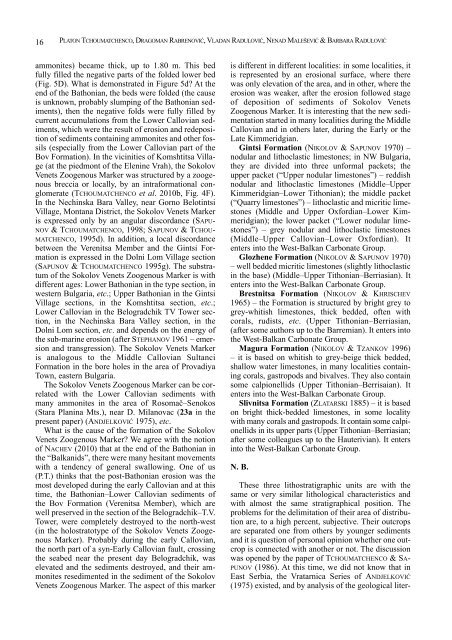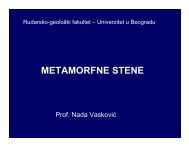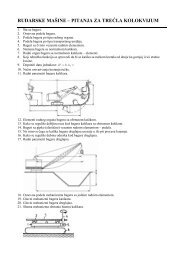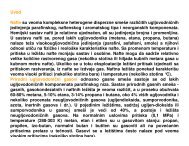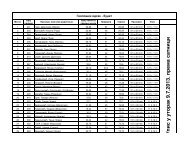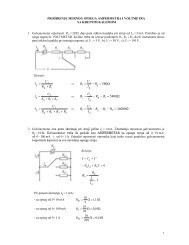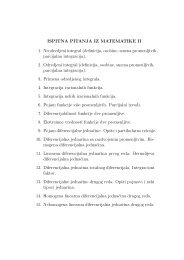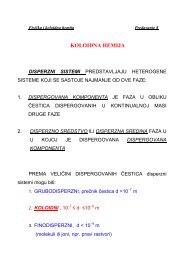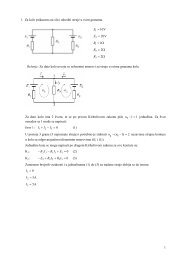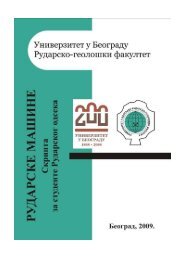KÑига LXXII
KÑига LXXII
KÑига LXXII
Create successful ePaper yourself
Turn your PDF publications into a flip-book with our unique Google optimized e-Paper software.
16<br />
PLATON TCHOUMATCHENCO, DRAGOMAN RABRENOVIĆ, VLADAN RADULOVIĆ, NENAD MALEŠEVIĆ & BARBARA RADULOVIĆ<br />
ammonites) became thick, up to 1.80 m. This bed<br />
fully filled the negative parts of the folded lower bed<br />
(Fig. 5D). What is demonstrated in Figure 5d? At the<br />
end of the Bathonian, the beds were folded (the cause<br />
is unknown, probably slumping of the Bathonian sediments),<br />
then the negative folds were fully filled by<br />
current accumulations from the Lower Callovian sediments,<br />
which were the result of erosion and redeposition<br />
of sediments containing ammonites and other fossils<br />
(especially from the Lower Callovian part of the<br />
Bov Formation). In the vicinities of Komshtitsa Village<br />
(at the piedmont of the Elenine Vrah), the Sokolov<br />
Venets Zoogenous Marker was structured by a zoogenous<br />
breccia or locally, by an intraformational conglomerate<br />
(TCHOUMATCHENCO et al. 2010b, Fig. 4F).<br />
In the Nechinska Bara Valley, near Gorno Belotintsi<br />
Village, Montana District, the Sokolov Venets Marker<br />
is expressed only by an angular discordance (SAPU-<br />
NOV & TCHOUMATCHENCO, 1998; SAPUNOV & TCHOU-<br />
MATCHENCO, 1995d). In addition, a local discordance<br />
between the Verenitsa Member and the Gintsi Formation<br />
is expressed in the Dolni Lom Village section<br />
(SAPUNOV & TCHOUMATCHENCO 1995g). The substratum<br />
of the Sokolov Venets Zoogenous Marker is with<br />
different ages: Lower Bathonian in the type section, in<br />
western Bulgaria, etc.; Upper Bathonian in the Gintsi<br />
Village sections, in the Komshtitsa section, etc.;<br />
Lower Callovian in the Belogradchik TV Tower section,<br />
in the Nechinska Bara Valley section, in the<br />
Dolni Lom section, etc. and depends on the energy of<br />
the sub-marine erosion (after STEPHANOV 1961 – emersion<br />
and transgression). The Sokolov Venets Marker<br />
is analogous to the Middle Callovian Sultanci<br />
Formation in the bore holes in the area of Provadiya<br />
Town, eastern Bulgaria.<br />
The Sokolov Venets Zoogenous Marker can be correlated<br />
with the Lower Callovian sediments with<br />
many ammonites in the area of Rosomač–Senokos<br />
(Stara Planina Mts.), near D. Milanovac (23a in the<br />
present paper) (ANDJELKOVIĆ 1975), etc.<br />
What is the cause of the formation of the Sokolov<br />
Venets Zoogenous Marker? We agree with the notion<br />
of NACHEV (2010) that at the end of the Bathonian in<br />
the “Balkanids”, there were many hesitant movements<br />
with a tendency of general swallowing. One of us<br />
(P.T.) thinks that the post-Bathonian erosion was the<br />
most developed during the early Callovian and at this<br />
time, the Bathonian–Lower Callovian sediments of<br />
the Bov Formation (Verenitsa Member), which are<br />
well preserved in the section of the Belogradchik–T.V.<br />
Tower, were completely destroyed to the north-west<br />
(in the holostratotype of the Sokolov Venets Zoogenous<br />
Marker). Probably during the early Callovian,<br />
the north part of a syn-Early Callovian fault, crossing<br />
the seabed near the present day Belogradchik, was<br />
elevated and the sediments destroyed, and their ammonites<br />
resedimented in the sediment of the Sokolov<br />
Venets Zoogenous Marker. The aspect of this marker<br />
is different in different localities: in some localities, it<br />
is represented by an erosional surface, where there<br />
was only elevation of the area, and in other, where the<br />
erosion was weaker, after the erosion followed stage<br />
of deposition of sediments of Sokolov Venets<br />
Zoogenous Marker. It is interesting that the new sedimentation<br />
started in many localities during the Middle<br />
Callovian and in others later, during the Early or the<br />
Late Kimmeridgian.<br />
Gintsi Formation (NIKOLOV & SAPUNOV 1970) –<br />
nodular and lithoclastic limestones; in NW Bulgaria,<br />
they are divided into three unformal packets; the<br />
upper packet (“Upper nodular limestones”) – reddish<br />
nodular and lithoclastic limestones (Middle–Upper<br />
Kimmeridgian–Lower Tithonian); the middle packet<br />
(“Quarry limestones”) – lithoclastic and micritic limestones<br />
(Middle and Upper Oxfordian–Lower Kimmeridgian);<br />
the lower packet (“Lower nodular limestones”)<br />
– grey nodular and lithoclastic limestones<br />
(Middle–Upper Callovian–Lower Oxfordian). It<br />
enters into the West-Balkan Carbonate Group.<br />
Glozhene Formation (NIKOLOV & SAPUNOV 1970)<br />
– well bedded micritic limestones (slightly lithoclastic<br />
in the base) (Middle–Upper Tithonian–Berriasian). It<br />
enters into the West-Balkan Carbonate Group.<br />
Brestnitsa Formation (NIKOLOV & KHRISCHEV<br />
1965) – the Formation is structured by bright grey to<br />
grey-whitish limestones, thick bedded, often with<br />
corals, rudists, etc. (Upper Tithonian–Berriasian,<br />
(after some authors up to the Barremian). It enters into<br />
the West-Balkan Carbonate Group.<br />
Magura Formation (NIKOLOV & TZANKOV 1996)<br />
– it is based on whitish to grey-beige thick bedded,<br />
shallow water limestones, in many localities containing<br />
corals, gastropods and bivalves. They also contain<br />
some calpionellids (Upper Tithonian–Berrisaian). It<br />
enters into the West-Balkan Carbonate Group.<br />
Slivnitsa Formation (ZLATARSKI 1885) – it is based<br />
on bright thick-bedded limestones, in some locality<br />
with many corals and gastropods. It contain some calpionellids<br />
in its upper parts (Upper Tithonian–Berriasian;<br />
after some colleagues up to the Hauterivian). It enters<br />
into the West-Balkan Carbonate Group.<br />
N. B.<br />
These three lithostratigraphic units are with the<br />
same or very similar lithological characteristics and<br />
with almost the same stratigraphical position. The<br />
problems for the delimitation of their area of distribution<br />
are, to a high percent, subjective. Their outcrops<br />
are separated one from others by younger sediments<br />
and it is question of personal opinion whether one outcrop<br />
is connected with another or not. The discussion<br />
was opened by the paper of TCHOUMATCHENCO & SA-<br />
PUNOV (1986). At this time, we did not know that in<br />
East Serbia, the Vratarnica Series of ANDJELKOVIĆ<br />
(1975) existed, and by analysis of the geological liter-


